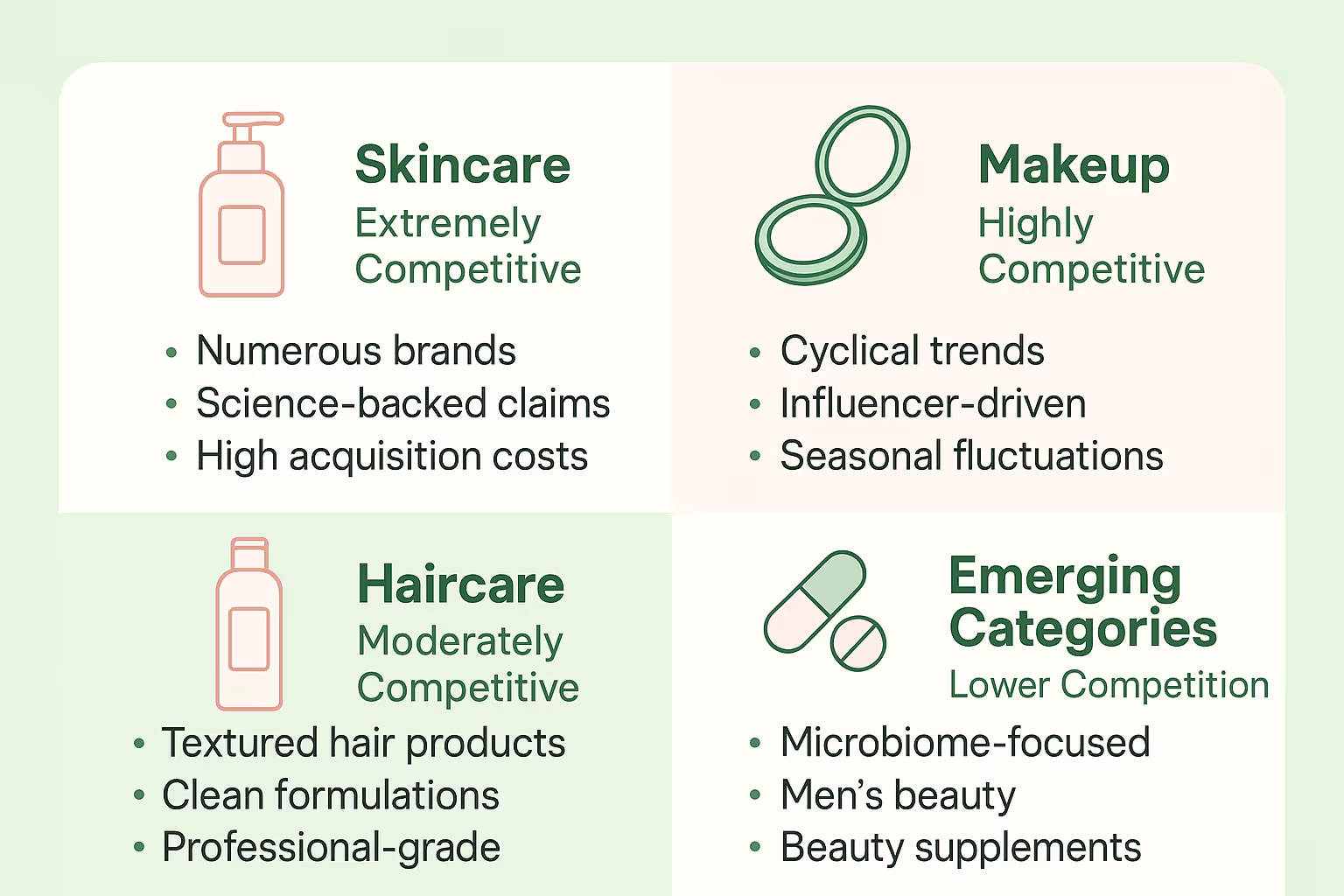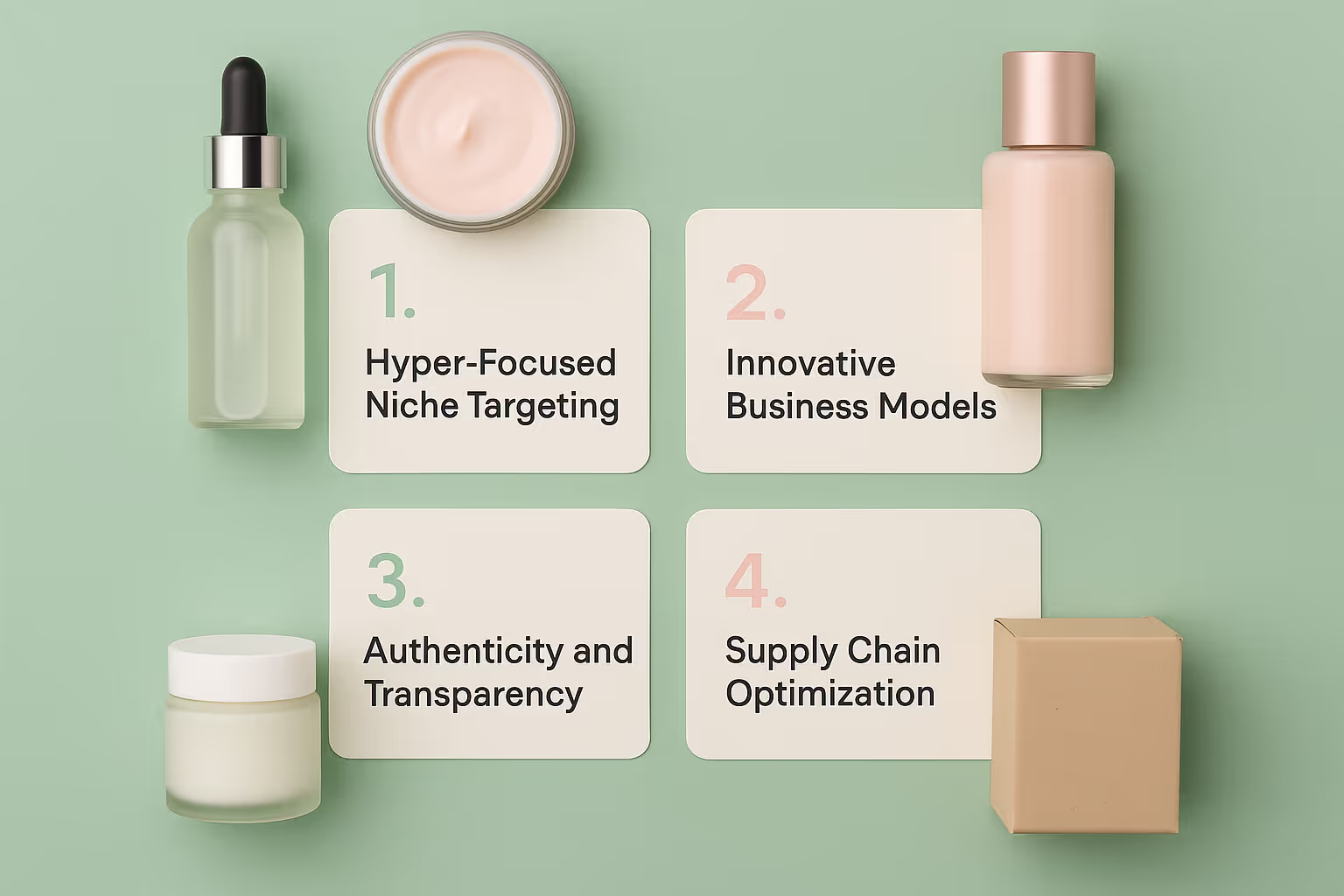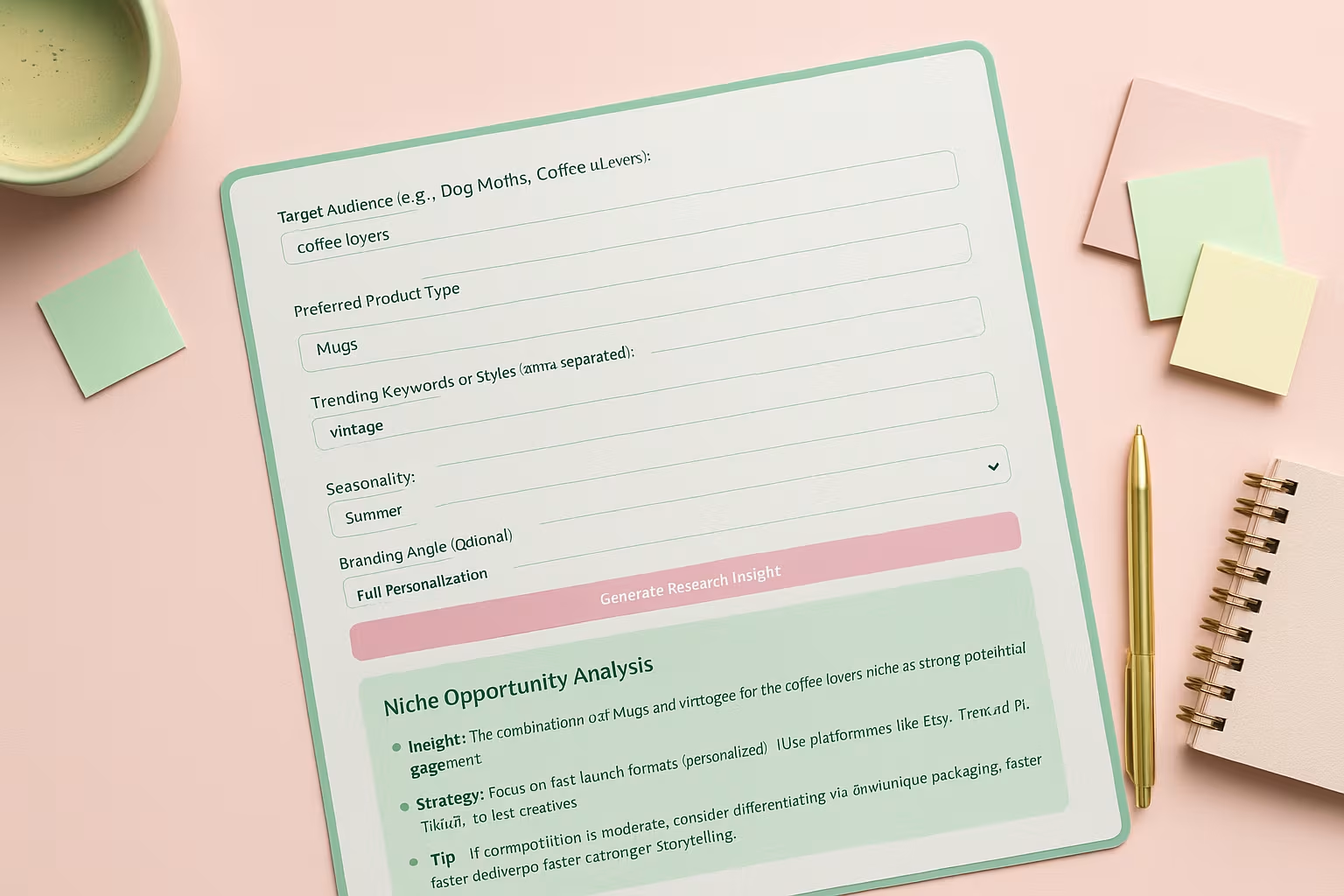
The beauty products industry is one of the most competitive markets globally. Valued at $570 billion in 2023 and projected to hit $720 billion by 2028, it grows 4–6% annually. From skincare to fragrance, competition is intense and constant.
Brands from global giants to indie startups are all fighting for consumer attention. Success depends on standing out in a crowded space. How competitive is the beauty products industry becomes a key question for growth-focused entrepreneurs.
Understanding this landscape helps brands act strategically. While skincare and makeup are saturated, clean beauty offers fresh opportunities. Smart positioning drives lasting success.
Factors to Consider for Beauty Industry Competition
The beauty industry's competitive landscape is characterized by several distinct tiers of competition. At the top sit global conglomerates like L'Oréal, Estée Lauder, and Unilever, which control dozens of brands across price points and categories.
The middle tier features established independent brands with loyal followings, while the bottom tier comprises thousands of emerging brands fighting for visibility.
Several key factors shape today's competitive environment:
Concentration of Market Power
The top 10 beauty conglomerates control approximately 70% of global beauty sales. These companies wield enormous advantages in manufacturing scale, retail relationships, and marketing budgets. However, they often move slowly compared to nimble startups.
Low Barriers to Entry, High Barriers to Scale
Starting a beauty brand has never been easier, thanks to contract manufacturers, turnkey formulations, and direct-to-consumer sales channels.
This has led to market saturation in many categories. The skincare industry is particularly competitive, with thousands of brands competing for consumer attention.
Shifting Consumer Loyalty
Modern beauty consumers are notoriously fickle, constantly seeking novelty and improvement. Brand loyalty has declined significantly, with 45% of consumers reporting they regularly switch between beauty brands.
This creates both vulnerability for established players and opportunity for newcomers with compelling offerings.
The "Dupes" Challenge
Beauty products face rapid commoditization as "dupes" (similar formulations at lower price points) emerge quickly. This puts pressure on margins and forces continuous innovation.
Pro Tip: The competitive data from established market research firms like Euromonitor or Mintel can cost thousands, but numerous beauty industry investors publish abbreviated market analyses for free as lead generation tools.
Search for "beauty industry investment report" to access professional-grade market intelligence without the hefty price tag.
Did you know 70% of beauty sales come from just 10 global players? If your brand isn’t positioned clearly, you’ll struggle to stand out or even survive. This matrix helps you find your place and spot exactly where to compete.
Beauty Industry Competition by Segment

Competition varies dramatically across beauty categories:
Skincare: Extremely Competitive
With profit margins often exceeding 80% and recurring purchase patterns, skincare attracts intense competition. The category features:
- Over 30,000 private label skincare brands globally
- Dominated by science-backed claims and ingredients
- High customer acquisition costs ($50-150 per customer)
- Saturated social media presence
Makeup: Highly Competitive with Cyclical Trends
Makeup follows trend cycles that create periodic windows of opportunity:
- Celebrity and influencer-driven purchasing
- High product turnover as trends shift
- Significant seasonal fluctuations
- Strong brand loyalty for specific product types (foundation, mascara)
Haircare: Moderately Competitive with Specialized Niches
The haircare sector offers more accessible entry points, particularly in:
- Textured hair products
- Clean/sustainable formulations
- Professional-grade products for home use
- Treatment-oriented products addressing specific concerns
Emerging Categories: Lower Competition, Higher Risk
Several newer categories present less saturated opportunities:
- Microbiome-focused skincare
- Men's targeted beauty
- Beauty supplements and ingestibles
- Personalized/custom formulations
How to Assess Your Competitive Position
Before entering the beauty market, conduct a thorough competitive analysis:
1. Identify Direct and Indirect Competitors
Map competitors across four categories:
- Direct competitors (same product type, similar positioning)
- Indirect competitors (different products solving the same problem)
- Aspirational competitors (where you aim to be in 3-5 years)
- Emerging threats (new technologies or business models)
2. Analyze Competitive Positioning
For each major competitor, assess:
- Price positioning (premium, mass, value)
- Key claims and differentiators
- Target demographic
- Distribution channels
- Content and marketing approach
3. Identify Market Gaps and Opportunities
Look for underserved segments through:
- Demographic analysis (age, ethnicity, gender identity)
- Price point gaps in the market
- Ingredient or formulation innovation opportunities
- Unaddressed customer pain points
4. Evaluate Market Entry Barriers
Assess challenges specific to your beauty segment:
- Regulatory requirements
- Manufacturing minimums
- Specialized expertise needed
- Patent or intellectual property considerations
Competitive Advantages in Beauty: Building Defensibility
In a crowded market, sustainable competitive advantages are crucial:
1. Proprietary Formulations and Ingredients
While rare, truly innovative formulations create lasting advantage:
- Patent-protected active ingredients
- Novel delivery systems
- Exclusive supplier relationships
- Proprietary manufacturing processes
2. Brand Positioning and Storytelling
The most defensible beauty brands build emotional connections:
- Authentic founder stories
- Clear mission and values alignment
- Consistent visual and tonal identity
- Community building rather than transactional relationships
3. Distribution and Channel Strategy
Strategic distribution creates competitive moats:
- Exclusive retail partnerships
- Direct-to-consumer relationships with high retention
- Professional/specialist channel penetration
- International market access
4. Vertical Integration Advantages
Controlling more of your supply chain builds an advantage:
- In-house formulation capabilities
- Private label manufacturing partnerships
- Owned fulfillment infrastructure
- Direct raw material sourcing
The Digital Transformation of Beauty Competition
Online channels have transformed competitive dynamics:
Social Media Battlegrounds
Beauty brands fight for visibility across platforms:
- TikTok drives trend acceleration and discovery
- Instagram remains central for brand building
- YouTube dominates detailed product education
- Pinterest influences purchasing consideration
Search Competition and Digital Visibility
SEO and digital advertising create significant barriers:
- Beauty-related keywords often cost $3-8 per click
- Dominant brands control top SERP positions
- Review platforms heavily influence purchase decisions
- Amazon's beauty category grows increasingly crowded
The Influencer Factor
Influencer relationships shape competitive advantage:
- Micro-influencers (10 K- 50 K followers) often deliver the best ROI
- Long-term partnerships outperform one-off collaborations
- Authentic product integration beats sponsored content
- Influencer saturation requires increasingly strategic approaches
Promoting beauty products effectively on social media requires sophisticated strategies that go beyond simple product posts.
Success Strategies in a Competitive Beauty Landscape

Despite fierce competition, several approaches prove effective:
1. Hyper-Focused Niche Targeting
Rather than competing broadly, successful new entrants often:
- Target extremely specific customer segments
- Address underserved skin concerns or conditions
- Focus on demographic groups ignored by major brands
- Specialize in particular product formats or applications
2. Innovative Business Models
Business model innovation often outperforms product innovation:
- Subscription-based replenishment
- Membership/community models with exclusive access
- Try-before-you-buy sampling programs
- Direct factory-to-consumer approaches
3. Authenticity and Transparency
Modern beauty consumers reward:
- Full ingredient transparency
- Honest efficacy claims
- Behind-the-scenes production insights
- Clear pricing rationales
4. Supply Chain Optimization
Competitive advantage increasingly comes from operations:
- Flexible manufacturing partnerships
- Agile inventory management
- Efficient fulfillment solutions
- Sustainable packaging innovations
Is Beauty Products Dropshipping Viable?
Given the intense competition, many entrepreneurs consider dropshipping as a lower-risk entry point. The viability of beauty products dropshipping depends on several factors:
Pros of Beauty Dropshipping
- Lower startup capital requirements
- Ability to test multiple products quickly
- No inventory management headaches
- Simplified operations
Cons of Beauty Dropshipping
- Thin profit margins (typically 15-30%)
- Limited product quality control
- Difficulty building brand loyalty
- Shipping times can disappoint customers
- Highly saturated with competitors
For most serious beauty entrepreneurs, dropshipping serves best as a testing mechanism rather than a long-term business model.
The most successful beauty brands eventually move toward private labeling or custom formulation to build sustainable differentiation.
Creating Your Competitive Strategy
Based on industry analysis, develop a clear competitive approach:
1. Define Your Defensible Difference
Identify what makes your beauty offering uniquely valuable:
- Proprietary formulation approach
- Unique ingredient sourcing
- Specialized expertise or credentials
- Distinctive brand positioning
2. Map Your Competitive Positioning
Position your brand about key competitors:
- Price point strategy (premium, accessible luxury, mass, value)
- Key attribute emphasis (efficacy, natural, luxury, convenience)
- Primary benefit focus (problem-solving vs. enhancement)
- Brand personality and emotional appeal
3. Develop a Channel Strategy
Determine where you'll compete (and where you won't):
- Dropshipping, direct-to-consumer vs. retail distribution
- Marketplace presence strategy
- International market approach
- Specialized channel opportunities (professional, medical, etc.)
4. Plan Your Competitive Evolution
Map how your competitive approach will evolve:
- Year 1: Initial differentiation and proof of concept
- Years 2-3: Expanding product line and distribution
- Years 3-5: Building defensible advantages
- Years 5+: Potential category expansion or acquisition positioning
Only Experts Would Know: Leverage Retail SKU Rationalization Reports for Positioning
Most beauty founders track trends, but experts go deeper with retail SKU rationalization data. These reports show which products retailers are cutting due to low performance.
It’s a smart way to avoid oversaturated formats or claims. In a crowded market, knowing what’s failing is just as valuable as spotting what’s hot.
For those navigating how competitive the beauty products industry is, this insight reveals where fatigue is setting in.
It helps you target underserved spaces with less resistance. Positioning becomes sharper, and innovation more strategic. Fewer surprises, more traction.
Your Beauty Brand's Path Forward
The beauty industry's competitive intensity shouldn't deter entry, it should shape a smarter strategy. Its ongoing growth and fragmentation offer space for focused, innovative brands with clear differentiation and lean operations.
Success lies in embracing competition. New brands can thrive by solving specific customer pain points, offering truly distinct products, and building authentic connections. With the right approach, even crowded markets hold real potential.
FAQ
Related blogs

Print on Demand Niche Research Tool: Find High-Intent Audiences Worth Designing For




